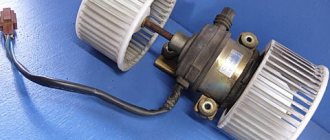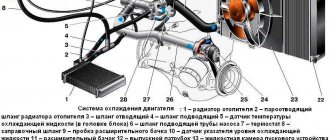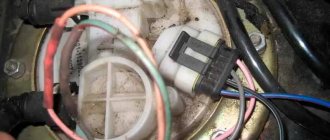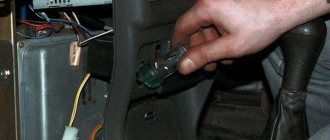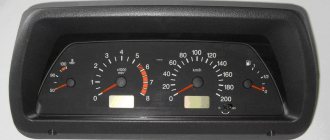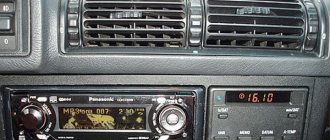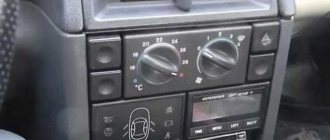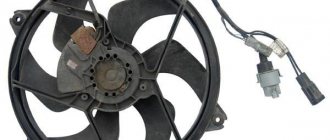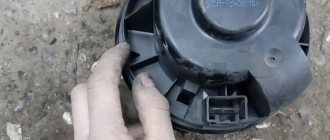Why doesn't the heater fan work?
In this article we will look at the main points and reasons why the stove (stove fan) does not turn on.
How can you tell if the heater fan is not turning on? – very simple: with the car running, turn on the heater at 1-2-3 speeds. If no additional “noise” appears, then the fan does not turn on. I would like to note right away that if the fan does not turn on, for example, at speed 1-2, but does turn on at speed 3, then the problem is in the additional resistor or in the heater operating intensity switch.
Let's figure out how the stove turns on in theory. Pay attention to the picture:
- 44 – fan motor;
- 45-additional resistor (used to regulate the speed of the electric motor, number 44);
- 46-position switch.
Diagnostics
The primary task is to identify the cause of the breakdown and assess your own capabilities in a specific situation.
Let's start with something simple and move on to something more complex:
- We check the fuse (F-7 with a voltage of 30 A), which is responsible not only for the heating system, but also for the operation of: the cigarette lighter, heated mirrors, glove compartment lights, and headlight washers. Therefore, when this fuse blows, all of the above devices refuse to work. If it is working, we move further along the chain.
- Turn on the car's ignition and switch the speed control to positions 1, 2, 3 in order. If the fan does not work in any of these positions, we move on.
- If the electric motor does not show signs of life in the first and second positions of the speed switch, but starts working in the third position (the fan is powered at the first and second speeds through a resistor, and at the third speed the current flows directly to the electric motor), the problem lies in the resistor or in the motor itself. switch
- If the heater motor turns on after the car engine has warmed up, the problem is a faulty ignition relay. Solved by replacing the relay.
- If the heater motor refuses to work in any mode, there remains one malfunction - the heater motor itself.
The process of dismantling the fan motor
For the final verdict, let’s apply “+” directly to the motor by removing the positive wire terminal from the motor. If the motor does not come to life, the last thing you can try is to try to clean the place under the ground mount on the electric motor. Often this place oxidizes and the contact weakens.
Why the stove motor does not work, the main reasons
- The fuse has blown.
The simplest and at the same time the most unpleasant malfunction, because replacing the fuse is very simple, and at the same time, we do not know the reason why it blew. Let me remind you that if a fuse blows, it means there is a short circuit somewhere (short circuit). In this case, you need to go through the entire fuse circuit and look for the source of the short circuit.
What fuse goes to the stove?
A fuse F7 with a current of 30A is attached to the stove. This fuse is also responsible for the cigarette lighter, headlight washer motor, glove compartment light, and heated rear window. So, if a fuse blows, then in addition to the heater fan, the above-mentioned electrical elements of the car will stop working.
- Poor contact in the mounting block.
Poor or oxidized contact in the mounting block is also a common disease. In this case, you need to move the block of flagella going to the mounting block.
If your stove is malfunctioning, for example, it only turns on when warm, then the problem is in the ignition relay. It’s surprising, of course, how the ignition relay affects the operation of the stove, but the fact remains a fact. The relay needs to be replaced. By the way, it is located under the instrument panel in the center console.
- The stove turns on only in position 3 of the switch.
If you encounter this situation, then you need to replace the additional resistor. The fact is that in positions 1 and 2 of the heater switch, current flows to the fan through an additional resistor, and in position 3 - directly to the fan. Therefore, the conclusion follows that the additional resistor is faulty. Additional heater resistor. Inspection, repair, replacement.
- The stove (heater) switch does not work.
To check the position switch (numbered 46 in the figure), we need a regular 12-volt marker light bulb with two soldered wires. We remove the center console of the instrument panel in order to gain access to the heater switch (How to remove the instrument panel?), then do the following: turn on the ignition; We close the negative wire of the light bulb to body ground, and connect the other to outputs 1-2-3 to an additional resistor (gray, white and red wire in the figure). If the light is on, then the switch is working; if it is not on, then we connect the lamp to the positive wire of the position switch (in the figure it is the blue-yellow wire). If the lamp does not light, then there is a break in the circuit somewhere or the fuse has blown out.
- The heater (heater fan) motor does not work.
If the heater switch works, there is voltage, but the fan does not turn on, then either it is burnt out, or there is poor contact of the fan ground (the ground is located under the heater mounting nut), or the motor brushes are stuck. The VAZ stove does not work, what should I do?
Where is the mass located?
When operating a car, it is important to know all the places where the mass of the VAZ 2114 engine is located. If a malfunction occurs in this direction, you can quickly detect the source of the problem and eliminate it accordingly.
So, where is the mass of the ECU for the VAZ 2114? Let's try to understand this issue. Where is the mass located on the VAZ 2114:
- Battery weight.
Battery weight of VAZ 2114
The negative battery branch consists of branches of wires of two types - thin and thick wire. The battery negative is directed to the motor housing using a thick wire. As a result of poor contact fastening, the charge will be supplied in a small volume, as a result, the starter will not be able to develop sufficient power, and the ECM will therefore fail, because it receives the required mass from the engine.
In order to check the negative charge connections between the battery and the engine, it is necessary to check the reliability of the two nuts, so you first need to loosen the nut from the outside and tighten the nut from the inside, and then screw the nut back on from the outside.
A thin negative wire is connected to the car body next to the battery. It plays the role of an energy source necessary for all consumers equipped in the car. To check, you also need to make sure the degree of tension of the nut both with the body and with the battery terminal.
- Weight of ECM VAZ 2114.
Weight of engines VAZ 2114
Samar engines with a volume of 1.5 liters take weight from the engine body, from the mounting plugs, which are located to the right of the cylinder head.
Samar engines with a volume of 1.6 liters, or 1.5 liters equipped with a new type of ECM, take weight from a welded stud. The pin is attached directly to the metal body of the instrument panel near the floor tunnel in the area under the ashtray. When assembled at the manufacturer's factory, the stud is usually poorly secured and painted, as a result, during operation of the machine it can become completely loose, as a result, when the ventilation device is turned on, the electrical voltage of the system will drop, and the following devices will react accordingly: mass air flow sensor, air metering sensor, air pressure sensor.
- Instrument panel weight.
Weight of the VAZ 2114 dashboard
In this version, there is a connection between the torpedo harness, the circuit from the mounting relay and fuse block, and the rear harness. This connection is located under the steering shaft mount. If the connection of this mount is not of good quality, problems may arise in the operation of the dashboard readings when the main energy consumers are turned on, for example: turn signals, headlights, etc.
- Electric motor heater weight
This ground connection is located under the instrument panel on the left side of the heater housing.
Introduction
Despite the fact that domestically produced cars are relatively durable, their heating system can fail much earlier. Having wished the “best” to the manufacturer, motorists whose VAZ-2115 heater fan does not work most often discover a problem in the cold season. Driving in a cold, unheated vehicle cannot be pleasant or comfortable; in addition, it is dangerous to health. It is worth noting that we are talking not so much about hypothermia, but about the danger of collision with other road users and structures. Due to the fact that the interior is not heated, the windows freeze very quickly, and a layer of frost and ice appears on them, preventing normal visibility.
Causes of heater fan malfunction
Replacing the stove motor may be necessary due to several problems, therefore, before taking active steps to repair the heating device, it is necessary to find out the reliable cause of the malfunction.
First of all, as practice shows, problems can begin with a failed fuse. Such a malfunction results in damage to the cigarette lighter, the illumination of the glove compartment, the electric pump (through which water cleans the headlights), and the heated rear window.
The second most common problem is the lack of contact, which should be inside the mounting block. In this case, the motorist needs to check the wiring in the block. If you have questions with the ignition relay, then most likely you will have to change this device. If the heater is not working in the first and second speed modes, the resistor will need to be replaced.
As practice shows, the heater fan on a VAZ-2115 can be replaced only after all of the above problems have been eliminated, and the faulty heater cannot operate normally. A problem with the fan motor can occur due to its failure. A small device may burn out, have poor contact with the power supply, or be the result of stuck fan brushes.
Heater fan diagram for VAZ 2114, 2115, 2113.
And so, here is a list of all components of the scheme:
- Mounting block (aka fuse block).
- Egnition lock.
- Ignition switch relief relay.
- Heater fan speed switch.
- Additional resistors.
- Stove motor.
- Rear window heating switch with warning lamp.
- Rear window heating element.
The scheme works as follows. When you turn the key in the ignition switch (2), its unloading relay (3) is turned on. The unloading relay supplies power to fuse f7 in the mounting block (1). After the fuse, power goes to the rear window heating switch (7) and the fan speed switch (4), which distributes which of the resistors (5) the power will go to next. Output 1 from the switch (4) corresponds to the slowest blowing speed, and output 3 goes directly to the heater motor (6), i.e. highest blowing speed.
The principle of replacing the valve of the VAZ-2115 stove
If the fan of the VAZ-2115 stove does not work, then you should immediately replace it completely. In almost any modern auto store you can find a decent fan option. As a rule, models from completely different price categories are suitable for a domestic VAZ-2115 car; naturally, you can install either a more budget-friendly Chinese version or a more reliable, durable unit. No one will be held responsible for the quality and service life of cheap fans, so it makes more sense to spend a little more money and buy a stronger device.
Changing a standard unit is easy, it is important to buy a worthy replacement. Some qualified experts recommend purchasing Luzar products, noting their fans as high-quality devices. The approximate cost of such a unit is within 1.2 thousand rubles.
If a motorist does not know how to remove the VAZ-2115 heater fan, he must first inspect its location. The VAZ heater motor is located in a special container (container), which is located in the windshield area in the hood compartment. You will need few tools; you should only stock up on a screwdriver and a set of keys.
To change the heater fan on a VAZ-2115, you should disconnect the negative terminal from the car’s battery, then from the passenger compartment under the instrument panel find the power wire (“plus”) of the heater motor and disconnect it.
To carry out the next step, you will have to sit under the hood of your car and get rid of the fan casing cover, which is held on by only 2 screws (they will need to be unscrewed).
To make the heater function perfectly, you will have to remove the entire “mass” of the heater motor; to facilitate the process, first of all, you will need to unscrew the nut securing the casing body at the bottom. Then you should open the casing itself and unscrew the 2 screws that hold the fan. Once these screws are removed, you will have to spend time removing the fasteners located in front of the windshield. Thanks to this procedure, the motorist will free the air intake grilles, which will subsequently need to be removed.
Replacing the stove fan on a VAZ-2115 will only be done after the old motor has been removed. You can remove the old device by unscrewing absolutely all the fasteners. It is worth noting that the unit being replaced is placed on a small hook located on the body. To do everything correctly, you need to move the hook forward a little and then lift it.
The VAZ-2115 stove fan must be removed from the hook by turning the unit 90°. Careful actions will allow the device to freely exit the casing.
Problems with the stove on a VAZ 2115
The VAZ-2115 is an updated version of the earlier G8, Nine and VAZ-21099. The same characteristics are available for the three- and five-door hatchbacks VAZ-2113 and VAZ-2114. The interior heater design in these cars is the same, so if you are the owner of one of the listed models, then this article should be of interest to you.
Let us also recall that we have already discussed on our website Vodi.su the question of how to fix problems with the stove on a VAZ-2109.
The device of the interior heater of the VAZ-2115
The stove design here is standard:
- fan - it directs the air flow;
- radiator - heated antifreeze from the engine enters it for cooling, and the heat generated during this is sent to the passenger compartment;
- heater tap - when you turn on the heater, the tap opens and antifreeze begins to flow into the heater radiator;
- damper rods - used to regulate the air supply, as well as to heat the legs and windshield;
- heater resistor - serves to create additional resistance so that you can select the operating mode of the stove.
The thermostat and the heater motor, which makes the fan spin, also play an important role. If the thermostat gets stuck, then the liquid will circulate only through the small or large circuit of the engine cooling system (and the interior heater belongs to it), accordingly, it will not have time to cool and the engine will overheat. If the stove motor breaks, the fan blades will stop rotating and warm air will not flow from the air ducts.
The system is quite simple and has been used previously on many cars, but over time various interruptions in operation begin. Breakdowns lead to the fact that the interior is very cold, hot air is not supplied to the glass and it fogs up, or your feet are cold because there is no airflow, and so on.
The stove does not blow - what is the reason?
If the stove stops working, there can actually be many reasons:
- the cylinder head gasket has burned out and the antifreeze level drops sharply - take immediate action, otherwise the engine may overheat;
- The thermostat is jammed - the coolant circulates through a small circuit very quickly and does not have time to cool;
- the heater radiator is clogged - in this case, air barely enters the cabin;
- the motor does not work;
- an air lock has formed - after turning off the engine, air accumulates in the system and enters the cooling radiator, and after starting the engine again, the radiator pump begins to pump this air into the heater radiator;
- The heater valve does not open completely - it may be clogged or the traction cable may be weakened;
- The radiator pump does not create sufficient pressure in the system; therefore, air either does not enter the cabin at all, or does, but with very low intensity.
The problem of failure of the traction rod, which opens the flaps for blowing the windshield or legs, may also affect it. And another very common problem is that the damper that cuts off the flow of cold air from outside does not work correctly - in this case, you need to adjust the cable that controls its movement.
Symptoms of malfunction
Heater device
The stove installed on the VAZ-2115 injector is exactly the same as on the earlier “nine”.
The main elements of the heating system are as follows:
- fan;
- radiator;
- air ducts;
- damper rods;
- heater valve;
- resistor;
- motor;
- thermostat.
Coolant, heated from a running 8-valve engine, enters directly into the radiator. The fan blows on the metal plates of the heat exchanger and the air heated in this way enters directly into the interior of the car.
Immediately after the heating circuit is turned on, the heating valve opens and supplies antifreeze to the radiator.
The rods regulate the air supply and the direction of its jets. With their help, you can provide heating to the windshield or direct hot air to frozen feet. By including a resistor in the circuit, it is possible to create a certain resistance, which allows you to regulate the operation of the heater. The thermostat ensures the movement of coolant through two circuits (small and large).
If the last device jams, then the movement of antifreeze occurs only through one of them, which increases the risk of overheating of the power plant. The heating of the car interior is organized through a large cooling circuit. That is, if the thermostat gets stuck on low, heating will not occur.
Often there are also problems with the fan motor. In this case, warm air will not be able to pass through the air ducts and deflectors in the cabin.
As you might guess, in general, the heating system is quite simple, and has previously been used in many other cars. New cars usually do not have any problems of this kind, but over time, as they are used, the chances of a breakdown increase significantly.
Heating system design
Such a system in these cars consists of several components. This is a fan that blows air over the heater radiator. The device also has air ducts and dampers. This is a separate damper for blowing the windshield, as well as a distribution one - it directs the air flow to the central and side deflectors, as well as to the floor. That's not all. There is also a control valve.
You will be interested in: Adjusting the valves of the 4216 Gazelle engine: procedure, technique for performing the work, necessary tools and expert advice
You can also highlight the stove faucet and the resistor that controls the power of the motor. There is also a switch that allows you to change the fan power.
You will be interested in: “Honda Insight Hybrid”: technical specifications, photos and reviews from owners
If the heating system is working properly, then the coolant heated from the engine is supplied to the heater radiator through the tap. The temperature of the air, which is pumped into the cabin by a fan, can be controlled - this is what the faucet is designed for. Heat is generated when a fan blows on the heater radiator, which is heated by coolant. When the car engine is heated to operating temperature, the temperature of the antifreeze or antifreeze can reach 95 degrees or more.
The stove on this car can operate in one of three modes. Modes allow you to change the fan speed. Depending on the position of the tap, you can supply both warm and cold air into the cabin.
All ground mounting points for the VAZ of the tenth family
| If the electrics in the car start to malfunction, then one of the reasons for this ailment may be poor fastening of the battery mass. Ten have features of mass fastenings depending on the engine and year of manufacture of the car. We check all the attachment points of the negative wire: |
Location of masses in the car interior
| 1 - fuse block.2 - near the driver’s right foot there is a shield, which is attached with a couple of screws, removing it, you will see that everything is like in the picture.3 - in principle, the situation is similar to the point described above, except that the shield is located next to with the left leg of the navigator. |
| The stud in the dashboard behind the mounting block, in order to find it, you need to bend in a certain way. The headlight hydraulic corrector is shown there for reference; the ground pin is located above and to the left of it. Through this mass, the windshield wipers, heater fan (21124) and door lock activators are powered. |
| The console is on the right side, from here it is more convenient to check the very important ground pin, through which the bracket under the ECU is connected to the car body, and accordingly the reliability of the ground of the ECM and the cooling fan depends - this nut also holds the corner that supports the far part of the left panel of the console. |
| ECM harness mass crimps in the console. The connector was removed from the ECU and pulled out onto the driver’s mat, it’s more convenient. I bit the fan ground wire out of the ignition circuit crimp (left in the photo), extended it, put the tip on and connected it separately to the bracket. I soldered all connections for reliability. |
| Weight of the Electric Fuel Pump (EFP) module and fuel level indicator. A black and white wire is attached to the left rear handbrake lever mounting bolt under the floor tunnel. The fuel pump is powered through this mass, and the accuracy of the fuel level reading also depends on it. |
| The ground is on the stud of the fuel pump flange; this wire most likely connects the pump housing to the fuel filter bracket and this was done for safety reasons to equalize the potentials of these two devices. |
It is easy to find the ground of the electric fuel pump module without removing the tunnel; just fold back the mat, slightly bend or carefully trim the carpet of the floor behind the driver's seat below the ashtray of the rear passengers, without damaging the ground wire itself. Then the carpet easily falls into place and the cut is almost invisible.
Location of masses under the hood of a car
The battery terminal is large and thick with a large cross-section wire (approximately 16 sq. mm). Its thick part, about the thickness of a little finger, connects the negative battery and the engine. If the contact of this wire is unreliable, there may be a deterioration in the battery charge, a decrease in the starter rotation speed when starting, as well as problems in the ECM system, because the minus comes from the engine, from the studs on which the ignition distributor hung on carburetor cars.
| The thin wire connecting the minus battery and the car body is the main connection for all electricity consumers in the car, and in carburetor modifications also for the engine. Through this connection, all the car's lighting equipment, radio and other devices are powered, depending on the year of manufacture of the car. |
| The connection point for the negative terminal of the battery to the engine block is connected to the upper stud of the thermostat, if you look behind the air filter. The cross-section of the wire was chosen based on the large current consumption of the starter; this wire can easily be traced by hand if it is led from the battery. The starter current flows through this wire, charging the battery, some sensors screwed into the engine block are connected through it |
| Nearby there is another ground connection point to the engine block, it is slightly higher and to the left. The 2112 engine has two brown wires connected to this place - this is the mass of the ECM, that is, the mass of the sensors, ignition module, ECU and cooling fan. The arrow below shows the engine (starter) ground wire from the battery. |
| The mass point under the adsorber - Miha [email protected] suggested that this is the mass of the right headlight and the mass of the right fog lamp. |
Fuse
It’s worth starting to look for the reason from the very beginning. Fuses usually blow. The malfunction is primitive, and you just need to replace the burnt one with a new one. But the fuse failed as a result of a short circuit, and the cause of the short circuit must be found.
This model has two safety blocks. The first can be found under the hood near the left glass, while the second is located in the cabin, under the panel. Two fuse blocks protect the circuits of certain devices.
You can find out which fuse is not working by looking at what is not working yet. For example, if the heater and washer of a VAZ 2115 do not work, then you need to find the fuse that is responsible for the operation of the washers. It is easy to find a burnt element - even an inexperienced driver can easily distinguish a burnt part from a whole one.
Although, due to a non-working heater in these models, there can only be one problem - fuse F7. It is located behind the heater, and the fuse itself is 40 A. It is responsible not only for the operation of the fan, but also for the washer, glove compartment lighting, heated rear window and cigarette lighter.
First and second position
If the heater only wants to work in the first and second positions, then you will have to be in the car for a long time without heating before it becomes warm. The heater is designed so that in the first and second positions the impulse to the fan comes from the resistor, and in the third position directly.
An additional resistor is needed in the system to ensure the best speed. The resistor has two spirals for two operating modes. When the first stove mode is turned on, the pulse passes through two spirals. If the second mode is turned on, the pulse will follow the second spiral. You can find the resistor near the accelerator pedal. Repairing it is unprofitable. Repairs can only be made if the contacts are burnt. It also makes sense to repair, if the wiring is burnt, it is replaced with a new one.
Remove the contacts from the resistor. Disconnect the fasteners and remove the element. Next, you need to make sure whether the part can be repaired. It is repaired or replaced with a new one.
No weight on the engine
If there is no ground on the engine, it is necessary to check the quality of all electrical system contacts coming directly from the engine housing.
Or you need to check the condition of the stud, because... The manufacturer does not process this type of equipment in any way other than painting, so they are often susceptible to oxidation or corrosion. As a result of using low-quality parts, voltage drops in the system, which is accompanied by a lack of mass on the engine, resulting in problems in the operation of the machine.
Cold air into the cabin
This may be due to various malfunctions. What could happen if the VAZ 2115 stove does not work? The reasons are improper replacement of the coolant, depressurization of the cooling system, and a small amount of antifreeze. To remove the plug from the system, you need to remove the heater radiator pipe and add coolant to the maximum. Then start and warm up the engine. The plug will come out on its own under fluid pressure.
Another nuisance is a jammed faucet. This may happen if the valve was not fully opened before, and during operation, scale appeared at its end, interfering with the normal circulation of the coolant. You can unscrew the tap with pliers or replace it.
The fan impeller may be damaged. It should be inspected and, if there is mechanical damage, replaced. If the cabin filter is dirty, then warm air will also not flow into the cabin. The filter needs to be changed.
